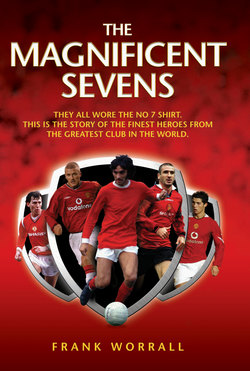Читать книгу The Magnificent Sevens - Frank Worrall - Страница 7
На сайте Литреса книга снята с продажи.
Preface
ОглавлениеManchester United – much to the joy of their followers and dismay of their bitterest opponents – remain the biggest club in the world. From Old Trafford to the Far East, no other football club can match their popularity and unrivalled support. And just as the Red Devils themselves are the stuff of legend, so is the coveted number 7 shirt at the club. It all started when Georgie Best decided it was his favourite number in the late Sixties and early Seventies. Yes, I know he also in his time wore 8 and 11, but it was the 7 shirt that will forever be associated with his greatest triumphs and memories.
Georgie-boy started off a trend that would encompass the greatest players of the next four decades – Bryan Robson in the Eighties, Eric Cantona in the early Nineties, and then David Beckham in the late Nineties and into the millennium. They were all eager to make their mark and earn a place in history as one of United’s fabled Magnificent Sevens.
Now Cristiano Ronaldo – who is as much loved by United fans and as reviled by rivals as the club itself after his exploits in the World Cup of 2006 – is the latest to pull on the iconic number 7 shirt and claim he is worthy of it.
All five men have something else in common – they have another side to them, not so much bad as mischievous and controversial. Indeed, it is this darker side that elevated them into the world-beaters they all became, that fuelled their very tunnel-visioned obsession to succeed. They were giants on the field, but human beings struggling with the enormity of a fame few of us can imagine off it. George Best reacted by frequently going AWOL to escape the pressure; Robson liked a drink or two; Beckham and Alex Ferguson famously often did not see eye to eye; Cantona’s frustrations erupted in angry outbursts, culminating in his infamous kung-fu kick on a taunting fan; and Ronaldo sent England crazy with his petulance, wicked winks and diving.
Could we have chosen other Sevens? Well, trawling the record books, there were only three other decent candidates – Johnny Berry from the Busby Babes era, Willie Morgan from the Seventies and Stevie Coppell, also from the Seventies and early Eighties. But none of them had the edge to become one of the Sevens – they were, for the most part, ‘what-you-see-is-what-you-get’ characters. They did not have the devil in them that went hand in hand with genius.
Berry was not a true Babe, in that he was not United bred. He was bought in from Birmingham for £15,000 aged 25 in 1951 and retired from the game after Munich seven years later. In his time at Old Trafford, he made 276 appearances and scored 45 goals and was renowned as being a tricky little winger with a lot of guts. As team-mate Dennis Viollet would say of Johnny, who played four times for England, ‘No one had more heart than Berry.’
Willie Morgan was another who gave fine service, but who was hardly of the calibre of George Best, the man he was brought in to replace from Burnley for a fee of £100,000 in 1968. Willie made 304 appearances for United, grabbing 34 goals, and represented his country, Scotland, at the 1974 World Cup Finals.
Stevie Coppell – who took over from Morgan at Old Trafford – was another right-winger renowned for his speedy, direct play. Of the three outsiders for a place in the Magnificent Sevens hall of fame, he remains my personal favourite – an intelligent, constructive player who lit up the Tommy Docherty era of bright, attacking football. Coppell made 496 appearances for United, scoring 70 goals after joining the club from Tranmere for £60,000 aged 20 in 1975. Coppell, who earned 42 England caps, is also famed for appearing in a Manchester United club record 206 consecutive league games between 15 January 1977 and 7 November 1981.
Yet Berry, Morgan and Coppell – the cream of the outsiders for a place in the Magnificent Sevens – remain decent bread-and-butter men in comparison to the five greats – Best, Robson, Cantona, Beckham and Ronaldo – five names you would surely gladly move heaven and earth to see even in this era of high prices and high-tech alternatives. With the help of new interviews and material, my aim is to cast a fresh eye over the famous five who make up United’s Magnificent Sevens – and to shed new light on their achievements, their failings and their ultimate legacies.
Frank Worrall, 2008
